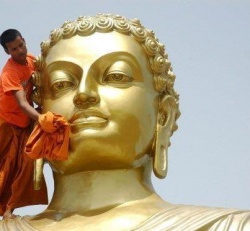Punabbhava
punabbhava: lit.: re-becoming; 'renewed existence', is a Sutta term for 'rebirth', which, in later literature mostly is called paṭisandhi (q.v.). The attainment of Sainthood (Arahatta), implying the end of future rebirths, is often expressed in the words: "This is the last birth. Now there is no more a renewed existence!" (natthi dāni punabbhavo) (M. 26; D. 15; Therag. 87, 339; Sn. 502). - The term is often linked with abhinibbatti ('arising').
"But how, o brother, does it come to renewed existence and arising in the future (āyatiṃ punabbhavābhinibbatti)? Because beings, obstructed by ignorance and fettered by craving, find ever fresh delight now here, now there, for this reason there is renewed existence and arising in the future" (M. 43). See also S.XII. 38. Abhinibbatti also stands sometimes alone in signifying 'rebirth', e.g. in A. VI, 61; X, 65.
Cf., in the 2nd Truth, the adj. ponobhavika, 'leading to renewed existence'.See A. III, 76; Sn. 163, 273, 514, 733; S. VII, 12; X, 3.
Renewed existence: punabbhava, again-becoming or rebirth.
punarbhava [punabbhava] rebirth. A living being is composed of five aggregates (skandha-s), namely, form, feeling, perception, mental formations and consciousness. These aggregates are always in a process of combining, dissolving and recombining. When a man dies these aggregates are dissolved. The upādāna and karma are two properties inherent in living beings. At death the five aggregates no longer exist in combination. But the upādāna, that is, clinging to existence continues to exist, and the karmic force remains undisturbed by the disintegration of the physical vehicle. A new existence is produced by upādāna. However, it is the karmic force that determines whether the being will be in the form of a human being, an animal, insect, God, Brahmā and likewise.
There is no soul which passes from one life to another. Each life is the karmic effect of the previous life and the cause of the one that follows. The karma is the result of craving which is an outcome of ignorance. Due to unfulfilled craving man desires for life and is born again. The appearance of the psycho-physical phenomena is conditioned by causes prior to birth.
Three types of consciousness function in a dying man's consciousness at the moment of death. They are rebirth linking consciousness [paṭisandhi-citta], the current of life continuum [bhavaṅga] and consciousness disconnecting the present life [cuti-citta]. At the last moment of the present life the rebirth linking consciousness arises. It remains for five thought-moments [javana] in the course of cognition and sinks down into the current of life continuum [bhavaṅga]. At the end of bhavaṅga, the consciousness disconnecting the present life [cuti-citta] arises. It disconnects the present life and sinks down into the current of life continuum [bhavaṅga]. At the end of that bhavaṅga another rebirth-linking consciousness arises in the next life. From this moment it is the new existence, the new life.
Rebirth takes place without anything transmigrating from one life to another. If the flame of a lamp is kindled from another one, one cannot say that one flame has passed over to the other flame. If a teacher teaches a verse to his pupil, the verse itself does not pass over from the teacher to pupil. In the same way rebirth takes place without anything transmigrating.
Life and death is a series such as the day and night, states of waking and sleeping. Just as the movement of a wave goes forward and not the substance, so there is rebirth without the soul. The body perishes and the force related to karma manifests itself into another existence which is called rebirth. The last thought-moment of the present life perishes conditioning another thought-moment in the next life. Nothing is transmigrated. The Buddhist tradition does not believe in the passing of a soul from one body to another. It is force of action resulting from the actions that passes from one life to another. It is the karmic force (karma) combined with upādāna, 'clinging to existence' that functions as the connecting link between past, present and future bodies of each living being.
